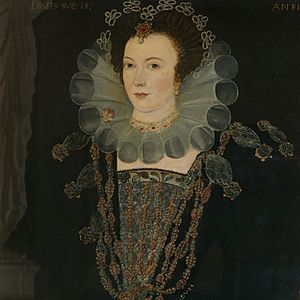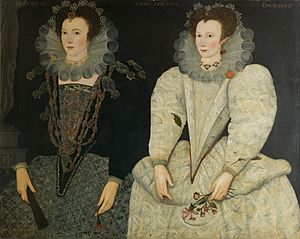Anne Newdigate (1574–1618) facts for kids
Quick facts for kids
Anne Newdigate
|
|
|---|---|

Anne Newdigate in 1592
|
|
| Born | 1574 |
| Died | 1618 |
| Known for | Correspondence |
| Children | 5 |
Anne Newdigate (née Fitton; 1574 – 1618) was an important gentlewoman and a skilled letter writer in England. Many of her letters are still around today. These letters give us a lot of information about her life and her family. They also help us learn more about her sister, Mary Fitton, who was often talked about at court. Some people even wonder if Mary was the "Dark Lady" mentioned in some of William Shakespeare's poems.
Contents
Anne's Early Life and Marriage
Anne Fitton was born in 1574. Her parents were Lady Alice and Sir Edward Fitton. Anne learned how to read and write, which was not common for all girls at that time.
When Anne was twelve years old, she married John Newdigate. He was sixteen at the time. This happened before John went to Brasenose College for his studies. Both Anne and John came from important families. However, they often struggled to have enough money for their big plans. Anne is known for being very good at managing their money. She helped them stay financially stable.
Living at Arbury Hall
For many years, Anne and John relied on her father's money. This was especially true while John was away at college. During that time, Anne lived at her parents' house. In 1592, Anne and her sister Mary Fitton had their portraits painted together.
In 1595, Anne and John moved into a house called Arbury Hall. This house was near Nuneaton. John's father had bought it in the 1580s. They lived there with an income of about 300 to 400 pounds a year.
Anne's Family and Connections
Anne Newdigate had five children. Her eldest child was a daughter named Mary (1598–1643). Her eldest son, John Newdigate (1600–1642), was set to inherit his father's property. Her next son was Richard Newdigate (1602–1678). Anne also had two younger daughters: Lettice (1604–1625) and Anne (1607–1637).
Lettice went to a school called Ladies Hall in Deptford starting in July 1617. A painting of Lettice at age two is now at Arbury Hall. This painting shows one of the earliest pictures of an English knot garden design.
Anne's Important Friends
Even though Anne moved to Arbury Hall, she was not cut off from society. She loved to write letters and kept in touch with many people. Her family and friends included many important people. Some of them were godparents to her children. These included:
- Sir William Knollys, who was an Earl and a Lord Chamberlain.
- Vice Admiral Sir Richard Leveson.
- Sir John Tonstal, who worked for Anne of Denmark, the Queen.
- Lettice, Lady Paget.
- Elizabeth, Lady Grey.
These connections helped Anne stay informed and supported.
Royal Visits and Court Life
In 1603, when James VI and I became King of England, he and Queen Anne of Denmark traveled to London. Many important people wanted to meet them along the way. Anne Newdigate knew that the King and Queen would pass through Coventry and Althorp.
William Knollys was a godparent to Anne's daughter, Mary. Knollys also wrote several letters to Anne about his strong interest in her sister, Mary.
Anne's Role as a Manager
Anne's detailed account books and her many letters show how important she was. She was the main person managing her family's money. People respected her for her skills. Francis Beaumont, a friend, praised her letter writing. She often exchanged news and ideas with other important women and men. These included Lady Lucy Percy, Sir Fulke Greville, Lady Margaret Hoby, Lady Grey, and Elizabeth and Lady Ashburnham.
Anne's sister, Mary, was often the subject of court gossip. Anne's friends and family helped her with various matters. One of her children's godparents even tried to get Anne a job as a royal wet-nurse for Princess Mary, but it did not work out.
Later Life and Legacy
Anne became a widow in 1610 when her husband died. His will made sure their children would be taken care of. However, it put Anne and the family's estate at risk of not having enough money. There was even a chance she might lose the right to care for her own children.
But Anne's excellent letter writing skills helped her. She wrote to Sir Robert Cecil, who was in charge of the master of the wards (a legal position). He said her letter was "passionate and moving." Because of her efforts, she was able to keep her son and protect her family's income. She even increased her income with the help of William Whitehall, who had worked for the family for a long time.
Anne chose not to marry again. Instead, she focused on arranging good marriages for her daughter Mary and her son John. She asked for advice and help from her influential friends and family. Sir John Tunstall, another godparent, helped Anne and her daughter Mary attend a Royal masque in January 1617. This was likely The Vision of Delight.
Anne became ill and returned to Warwickshire later that year. She died in June of the following year, 1618. William Whitehall continued to serve the Newdigate family after her death.
Her son, John Newdigate, became an adult in 1621. He married Susannah Lulls (1597-1654). Susannah was the daughter of Arnold Lulls, a jeweler who worked for the royal court. There was a court case about the payment of her dowry, which was the money or property she brought into the marriage.

Images for kids
-
Lettice Newdigate aged two with Knot garden design on her bodice and to the right.




